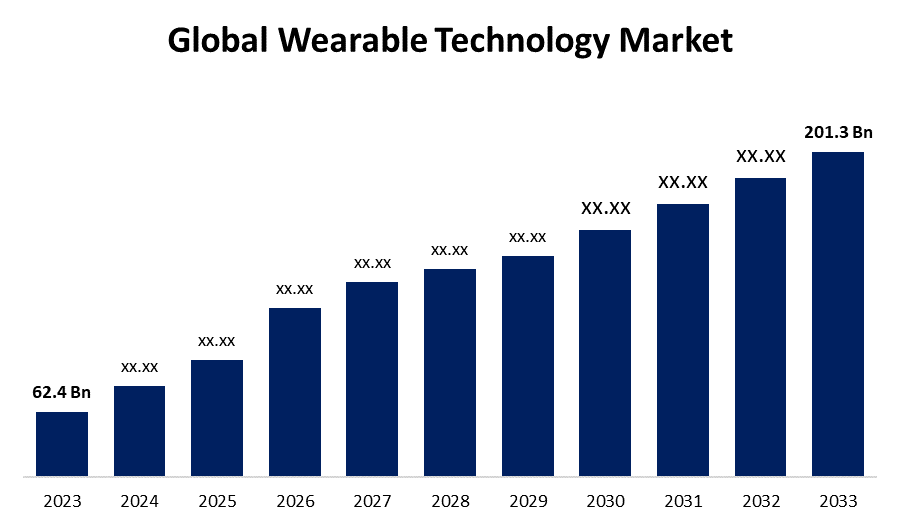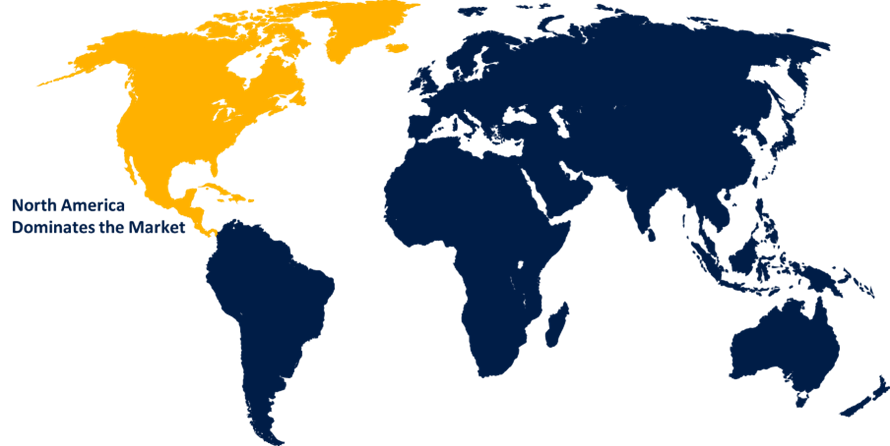Global Wearable Technology Market Size, Share, Growth, and Industry Analysis, By Type (Smart Glasses, VR Headsets, Smart Jackets and Smart Rings, Smart Watches, and Fit Bands), By Technology (IoT Based, AR & VR, and Others), By End Use (Health and Fitness, BFSI, Gaming and Entertainment, Fashion, Travel, Education, and Logistics & Warehouse), and By Regional (North America, Europe, Asia Pacific, South America, Middle East & Africa) Insights and Forecast to 2033
Industry: Information & TechnologyGlobal Wearable Technology Market Insights Forecasts to 2033
- The Global Wearable Technology Market Size was Valued at USD 62.4 Billion in 2023
- The Market Size is Growing at a CAGR of 12.43% from 2023 to 2033
- The Worldwide Global Wearable Technology Market Size is Expected to Reach USD 201.3 Billion by 2033
- Asia Pacific is Expected to Grow the fastest during the forecast period.

Get more details on this report -
The Global Wearable Technology Market Size is Anticipated to Exceed USD 201.3 Billion by 2033, Growing at a CAGR of 12.43% from 2023 to 2033. The market growth during the forecast period is driven by the rising prospects of next-generation displays in wearable devices, increased demand for IoT devices, and the growing need for smart devices in healthcare applications.
GLOBAL WEARABLE TECHNOLOGY MARKET REPORT OVERVIEW
Wearable technology refers to electronic devices designed to be worn on the body, often as accessories, clothing, or implants. These devices integrate advanced sensors and software to collect data and provide real-time feedback or connectivity. Common examples include smartwatches, fitness trackers, and augmented reality glasses. Wearable technology is utilized in various sectors, including healthcare for monitoring vital signs, fitness for tracking physical activity, and communication for notifications and calls. The primary goal is to enhance convenience, health, and connectivity by seamlessly integrating technology into daily life.
For instance, in March 2022, Xiaomi Corp. launched the Xiaomi Watch S1 Series. This latest addition features 117 fitness modes and offers comprehensive tracking for blood oxygen saturation, health monitoring, and sleep monitoring. Additionally, it includes magnetic charging capabilities and integrates Amazon’s Alexa voice assistant.
Wearable technology devices are equipped with advanced sensors that monitor various health metrics, including cholesterol levels, calories burned, and oxygen levels. Companies like Fitbit, Samsung, Noise, and Fossil Group, Inc. are leading the way by introducing health-tracking solutions in their wearable products, such as watches and other accessories. These features are designed to attract health-conscious consumers, providing them with convenient tools to monitor their well-being, which in turn drives market growth.
Report Coverage
This research report categorizes the market for the global wearable technology market based on various segments and regions forecasts revenue growth and analyzes trends in each submarket. The report analyses the key growth drivers, opportunities, and challenges influencing the global wearable technology market. Recent market developments and competitive strategies such as expansion, product launch, and development, partnership, merger, and acquisition have been included to draw the competitive landscape in the market. The report strategically identifies and profiles the key market players and analyses their core competencies in each sub-segment of the global wearable technology market.
DRIVING FACTORS:
“Increasing Adoption of Smart Clothing Fuels Market Growth”
Smart wear is anticipated to see increased mainstream consumer adoption, driven by collaborations between fashion and tech brands. An example is the Levi Commuter x Jacquard Jacket, which allows users to control their mobile phones, access Google services, and use gestures to track their Uber location. A 2023 research survey indicated that the smart clothing sector accounts for 9% of wearable trend development, as more people become aware of fitness and activity patterns. Companies are also exploring specialized wearable technology applications, such as the Nadi smart yoga pants that connect to the wearer's smartphone app. The advantage of smart clothing over smaller accessories like watches and bracelets is its ability to cover a larger body area, offering deeper and more practical benefits. Wearable X, a fashion tech company, exemplifies this by combining hardware, software, and clothing with haptic technology in a unique way.
RESTRAINING FACTORS:
“Limited Battery Life of Wearable Devices Hinders Market Growth”
The lack of a reliable and efficient battery structure, without compromising the ease of use and compactness of wearable devices, limits market growth. Major challenges include managing power demand, reducing power consumption, and improving battery recharging. Achieving energy efficiency in portable devices through cost-effective power consumption control is expected to remain a significant limiting factor in the market.
Market Segmentation
The Global Wearable Technology Market share is classified into type, technology, and end use.
Which segment is expected to hold the largest share of the global wearable technology market during the forecast period?
“The VR headsets segment dominates the market with the highest market share over the forecast period”
Based on the type, the global wearable technology market is categorized into smart glasses, VR headsets, smart jackets and smart rings, smartwatches, and fit bands. Virtual Reality (VR) technology holds significant potential across a range of applications, including industrial prototyping, medical training, and education. As both businesses and consumers increase their investments in VR technology, the demand for these solutions is anticipated to grow. The expanding use of virtual reality is directly influencing the development and advancement of the VR headset industry. Enhanced VR capabilities are fostering innovations and creating new opportunities within these sectors, further accelerating industry growth. As companies continue to integrate VR into their operations and educational institutions leverage it for immersive learning experiences, the market for VR headsets is expected to see substantial expansion.
Why IOT based is Preferred over AR & VR, and Others?
“IoT wearables advance healthcare significantly.”
Based on the technology, the global wearable technology market is categorized into IoT based, AR & VR, and others. The Internet of Things (IoT) is a rapidly expanding field with the potential to transform multiple industries and improve everyday life. Advances in microelectronics have led to the creation of smaller, more energy-efficient components, allowing for the integration of sensors, processors, and communication modules into compact wearable devices. IoT-based wearables are increasingly used in healthcare for early medical condition detection, remote patient monitoring, and continuous health tracking, driving the growth of IoT technology.
Which segment is anticipated to dominate the global wearable technology market during the forecast period?
“The health & fitness segment dominates the market with the highest market share over the forecast period”
Based on the end use, the global wearable technology market is categorized into health and fitness, BFSI, gaming and entertainment, fashion, travel, education, and logistics & warehouse. As individuals become more conscious of fitness and health, wearable devices offer real-time data on vital health metrics, promoting a proactive approach to well-being. Furthermore, the growth of remote health monitoring enables healthcare providers to track patients' conditions and progress without needing physical presence at healthcare facilities. This is especially beneficial for patients with chronic illnesses and contributes to the expansion of this market segment.
Regional Segment Analysis of the Global Wearable Technology Market
- North America (U.S., Canada, Mexico)
- Europe (Germany, France, U.K., Italy, Spain, Rest of Europe)
- Asia-Pacific (China, Japan, India, Rest of APAC)
- South America (Brazil and the Rest of South America)
- The Middle East and Africa (UAE, South Africa, Rest of MEA)
Which region is expected to hold the largest share of the global wearable technology market over the forecast period?
“North America is anticipated to hold the largest share of the global wearable technology market over the forecast period”

Get more details on this report -
North America region is a center for technological innovations and advancements, with its robust research and development capabilities driving the creation of state-of-the-art wearable devices featuring advanced sensors, processors, and connectivity. The increasing emphasis on health and fitness in North America has heightened the demand for wearables that monitor and track health metrics like heart rate, sleep patterns, and physical activity. Consumers in the region are eager to embrace technologies that support healthier lifestyles.
Why Asia Pacific is growing at the fastest CAGR in the global wearable technology market?
“Asia Pacific's rapid urbanization, high smartphone penetration, and 5G integration are driving the growing demand for wearable technology”
The Asia Pacific region’s swift urbanization and rising disposable income have driven growing demand for wearable technology. Asia Pacific's strong mobile-first culture, characterized by widespread smartphone and mobile device usage, aligns well with wearables that integrate with mobile apps and services, boosting market growth. Additionally, the expanding integration of 5G technology into wearables across various industries, including manufacturing and logistics, enhances operational efficiency and improves employee safety.
Competitive Analysis:
The report offers the appropriate analysis of the key organizations/companies involved within the global wearable technology market along with a comparative evaluation primarily based on their product offering, business overviews, geographic presence, enterprise strategies, segment market share, and SWOT analysis. The report also provides an elaborative analysis focusing on the current news and developments of the companies, which includes product development, innovations, joint ventures, partnerships, mergers & acquisitions, strategic alliances, and others. This allows for the evaluation of the overall competition within the market.
List of Key Companies
- Samsung Group
- Apple, Inc.
- Fitbit, Inc.
- Philips
- Sony Corporation
- Xiaomi
- LG Electronics
- Huawei
- Adidas AG
- Nike, Inc.
- Microsoft Corporation
- Garmin Ltd
- Fossil Group
- Alphabet Inc.
- DAQRI Company
- AIQ Smart Clothing Inc.
- HTC Corporation
- Others
Recent Developments
- In September 2023, Apple Inc. (US) introduced its latest innovation, the Apple Watch Series 9. This new addition to the Apple Watch lineup features advanced health and fitness tracking capabilities, enhanced performance, and improved design elements.
- In January 2023, Philips and Masimo broadened their partnership to improve patient monitoring in-home telehealth applications by leveraging the advanced health-tracking features of the Masimo W1 watch. This watch will integrate with Philips's enterprise patient monitoring ecosystem, enhancing capabilities in telemonitoring and telehealth.
Key Target Audience
- Market Players
- Investors
- End-users
- Government Authorities
- Consulting And Research Firm
- Venture capitalists
- Value-Added Resellers (VARs)
Market Segment
This study forecasts revenue at global, regional, and country levels from 2020 to 2033. Spherical Insights has segmented the global wearable technology market based on the below-mentioned segments:
Global Wearable Technology Market, By Type
- Smart Glasses
- VR Headsets
- Smart Jackets and Smart Rings
- Smart Watches
- Fit Bands
Global Wearable Technology Market, By Technology
- IoT Based
- AR & VR
- Others
Global Wearable Technology Market, By End Use
- Health and Fitness
- BFSI
- Gaming and Entertainment
- Fashion
- Travel
- Education
- Logistics & Warehouse
Global Wearable Technology Market, By Regional Analysis
- North America
- US
- Canada
- Mexico
- Europe
- Germany
- UK
- France
- Italy
- Spain
- Russia
- Rest of Europe
- Asia Pacific
- China
- Japan
- India
- South Korea
- Australia
- Rest of Asia Pacific
- South America
- Brazil
- Argentina
- Rest of South America
- Middle East & Africa
- UAE
- Saudi Arabia
- Qatar
- South Africa
- Rest of the Middle East & Africa
Frequently Asked Questions (FAQ)
-
1. What is the CAGR of the global wearable technology market?The global wearable technology market is projected to expand at 12.43% during the forecast period.
-
2. Who are the top key players in the global wearable technology market?The key players in the global wearable technology market are Samsung Group, Apple, Inc., Fitbit, Inc., Philips, Sony Corporation, Xiaomi, LG Electronics, Huawei, Adidas AG, Nike, Inc., Microsoft Corporation, Garmin Ltd, Fossil Group, Alphabet Inc., DAQRI Company, AIQ Smart Clothing Inc., HTC Corporation, Others.
-
3. Which region is expected to hold the largest share of the global wearable technology market?The North America region is expected to hold the largest share of the global wearable technology market.
Need help to buy this report?